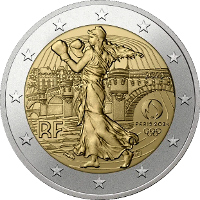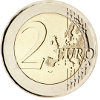 |
C o m m e m o r a t i v e
C o i n s |
||
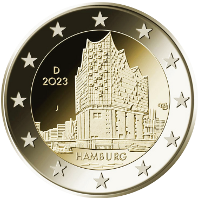 🔎
🔎 |
 |
Germany | 24 Jan. 2023 | Hamburg (Elbphilharmonie) 1st coin in the 2nd Federal States series |
20003 20005 20009 |
30,331,200 |  |
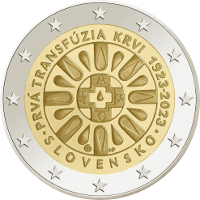 🔎
🔎 |
 |
Slowakia | 02 Mar. 2023 | 100 anniversary of the first blood transfusion in Slovakia |
20003 20005 20009 |
1,000,000 |  |
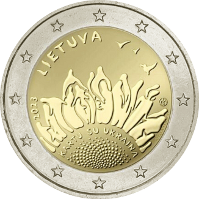 🔎
🔎 |
 |
Lithuania | 16 Mar. 2023 | Together with Ukraine |
20003 20005 20009 |
500,000 |  |
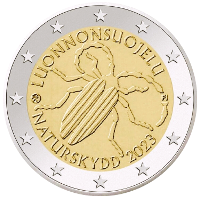 🔎
🔎 |
 |
Finland | 21 Mar. 2023 | First Finnish Nature Conservation Act (1932) |
20003 20005 20009 |
405,000 |  |
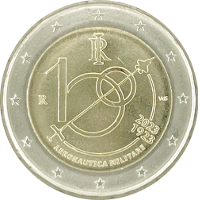 🔎
🔎 |
 |
Italy | 21 Mar. 2023 | 100th anniversary of the Italian Air Force |
20003 20005 20009 |
3,032,000 |  |
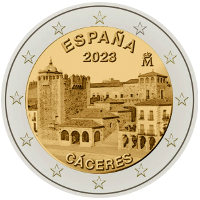 🔎
🔎 |
 |
Spain | 28 Mar. 2023 | Old Town of Cáceres 14th coin in the UNESCO Wourld Heritage Sites series |
20003 20005 20009 |
1,500,000 |  |
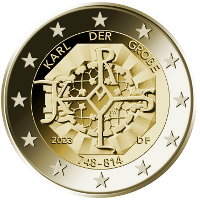 🔎
🔎 |
 |
Germany | 30 Mar. 2023 | 1275th Birthday of Charlemagne |
20003 20005 20009 |
20,275,000 |  |
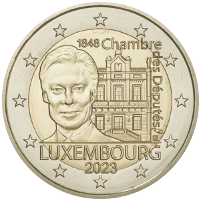 🔎
🔎
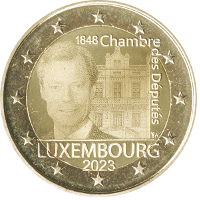 🔎
🔎 |
 |
Luxembourg | 24 Apr. 2023 | 175th anniversary of the Chamber of Deputies and of the First Constitution 29th coin in the Grand‐Ducal Dynasty series |
20003 20005 20009 |
133,500 |  |
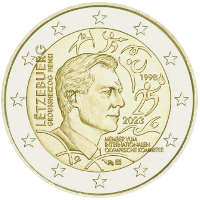 🔎
🔎
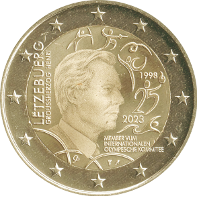 🔎
🔎 |
 |
Luxembourg | 24 Apr. 2023 | 25th anniversary of the admission of Grand Duke Henri as a member of the
International Olympic Committee 30th coin in the Grand‐Ducal Dynasty series |
20003 20005 20009 |
133,500 |  |
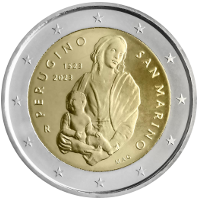 🔎
🔎 |
 |
San Marino | 27 Apr. 2023 | 500th anniversary of the death of Pietro Perugino |
20003 20005 20009 |
56,000 |  |
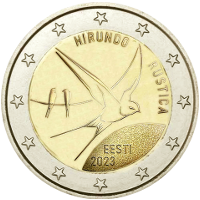 🔎
🔎 |
 |
Estonia | 12 May 2023 | The Barn Swallow, Estonia's National Bird 2nd coin of the national symbols of Estonia series |
20003 20005 20009 |
1,000,000 |  |
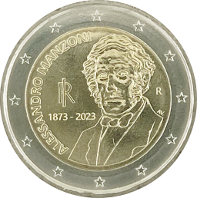 🔎
🔎 |
 |
Italy | 15 May 2023 | 150th anniversary of the death of Alessandro Manzoni |
20003 20005 20009 |
3,027,000 |  |
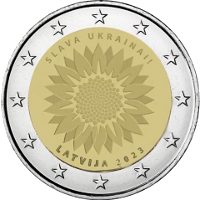 🔎
🔎 |
 |
Latvia | 30 May 2023 | The Sunflower of Ukraine |
20003 20005 20009 |
410,000 |  |
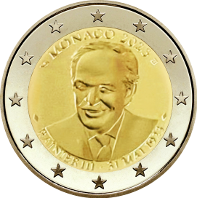 🔎
🔎 |
 |
Monaco | 31 May 2023 | The centenary of the birth of Prince Rainier III |
20003 20005 20009 |
25,000 |  |
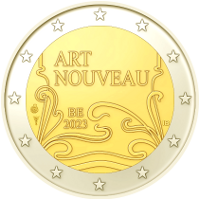 🔎
🔎 |
 |
Belgium | 20 Jun. 2023 | Year of Art Nouveau |
20003 20008 20009 |
155,000 |  |
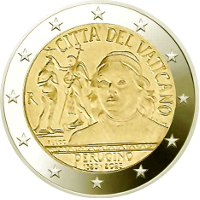 🔎
🔎 |
 |
Vatican City | 20 Jun. 2023 | 150th anniversary of the death of Pietro Perugino |
20003 20005 20009 |
78,500 |  |
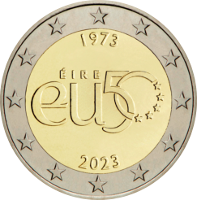 🔎
🔎 |
 |
Ireland | 22 Jun. 2023 | 50th anniversary of accession to the EU |
20003 20008 20009 |
501,000 |  |
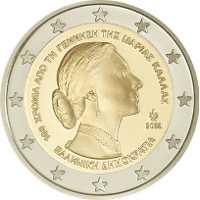 🔎
🔎 |
 |
Greece | 27 Jun. 2023 | 100th birthday of Maria Callas |
20003 20005 20009 |
750,000 |  |
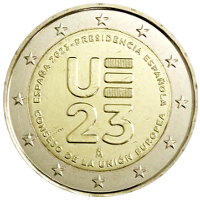 🔎
🔎 |
 |
Spain | 03 Jul. 2023 | EU Presidency 2023 |
20003 20008 20009 |
1,500,000 |  |
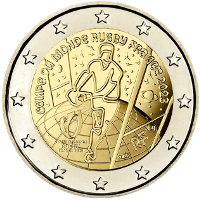 🔎
🔎 |
 |
France | 04 Jul. 2023 | Rugby Union World Cup ‐ France 2023 |
20003 20005 20009 |
15,120,000 |  |
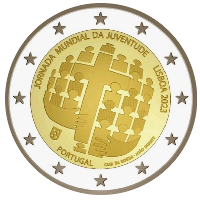 🔎
🔎 |
 |
Portugal | 19 Jul. 2023 | World Youth Day Lisbon 2023 |
20003 20005 20009 |
1,015,000 |  |
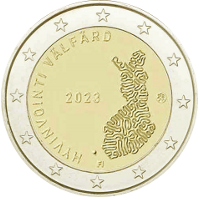 🔎
🔎 |
 |
Finland | 07 Aug. 2023 | Social and health services as safeguards for citizens' well‐being |
20003 20005 20009 |
400,000 |  |
 🔎
🔎 |
 |
San Marino | 05 Sep. 2023 | 500th anniversary of the death of Luca Signorelli |
20003 20005 20009 |
56,000 |  |
 🔎
🔎 |
 |
Greece | 14 Sep. 2023 | 150th birthday of Constantin Carathéodory |
20003 20005 |
750,000 |  |
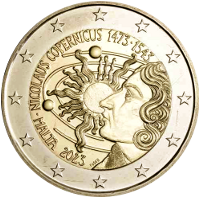 🔎
🔎 |
 |
Malta | 14 Sep. 2023 | 550th anniversary of the birthday of Nicolaus Copernicus |
20003 20005 20009 |
90,500 |  |
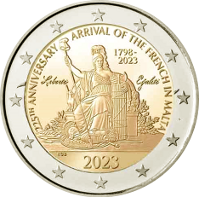 🔎
🔎 |
 |
Malta | 14 Sep. 2023 | 225th anniversary of the arrival of the French in Malta |
20003 20005 |
80,500 |  |
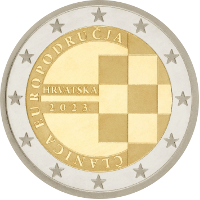 🔎
🔎 |
 |
Croatia | 15 Sep. 2023 | The introduction of the Euro as currency of Croatia on 01.01.2023 |
20003 20005 20009 |
255,000 |  |
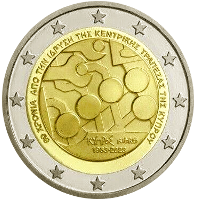 🔎
🔎 |
 |
Cyprus | 02 Oct. 2023 | 60th anniversary of the establishment of the Central Bank of Cyprus |
20003 20005 |
412,000 |  |
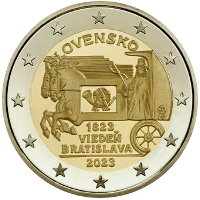 🔎
🔎 |
 |
Slovakia | 11 Oct. 2023 | 200th anniversary of the start of regular horse‐drawn express mail service between Vienna and Bratislava |
20003 20005 |
1,000,000 |  |
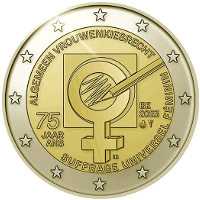 🔎
🔎 |
 |
Belgium | 25 Oct. 2023 | 75 Years of Women's Suffrage in Belgium |
20003 20005 |
130,000 |  |
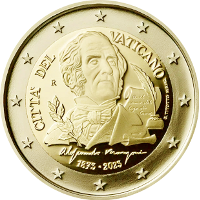 🔎
🔎 |
 |
Vatican City | 27 Oct. 2023 | 150th anniversary of the death of Alessandro Manzoni |
20003 20005 |
78,500 |  |
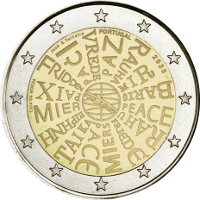 🔎
🔎 |
 |
Portugal | 15 Nov. 2023 | Peace |
20003 20005 |
515,000 |  |
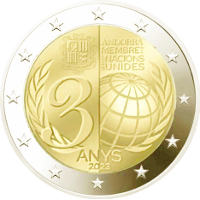 🔎
🔎 |
 |
Andorra | 27 Nov. 2023 | 30. anniversary od Andorra's accession to the UN |
20003 20005 |
70,000 |  |
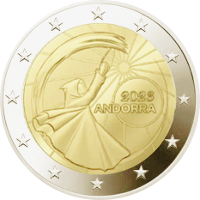 🔎
🔎 |
 |
Andorra | 27 Nov. 2023 | Fire festivals for the summer solstice |
20003 20005 |
70,000 |  |
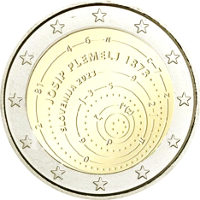 🔎
🔎 |
 |
Slovenia | 19 Dec. 2023 | 150th birthday of Josip Plemelj |
20003 20005 |
1,000,000 |  |
 Work in progress |
|||||||
| ⇓ 2024 ⇓ |
| References : | |||
| 20001 | Images taken with authorisation by the ECB - Mail dated 20.Feb.2020 © "European Central Bank" |
20002 | Data mirrored from Wikipedia Page "2_euro_commemorative_coins" with friendly support of the guardians of that page. |
| 20003 | Images taken with authorisation by H....... Hamburg | 20004 | Coloured version of this Commemorative Coin in circulation EU‐legal‐technical specifications do not recongnise colour prints. The EU nevertheless tolerates them, as their numbers are very small and they are sold in special packs and therefor are very unlikely to be used as currency. |
| 20005 | enlarged Images taken with authorisation by Gerd Seyffert © "Gerd Seyffert 2021" |
20006 | Not Applicable |
| 20007 | Images taken by Münzen Kreuzberg © "Münzen Kreuzberg 2021" |
20008 | enlarged Images taken by Münzen Kreuzberg © "Münzen Kreuzberg 2021" |
| 20009 | Text with kind permission by Gerd Seyffert © "Gerd Seyffert 2023" |
20010 | Not Applicable |
 |
